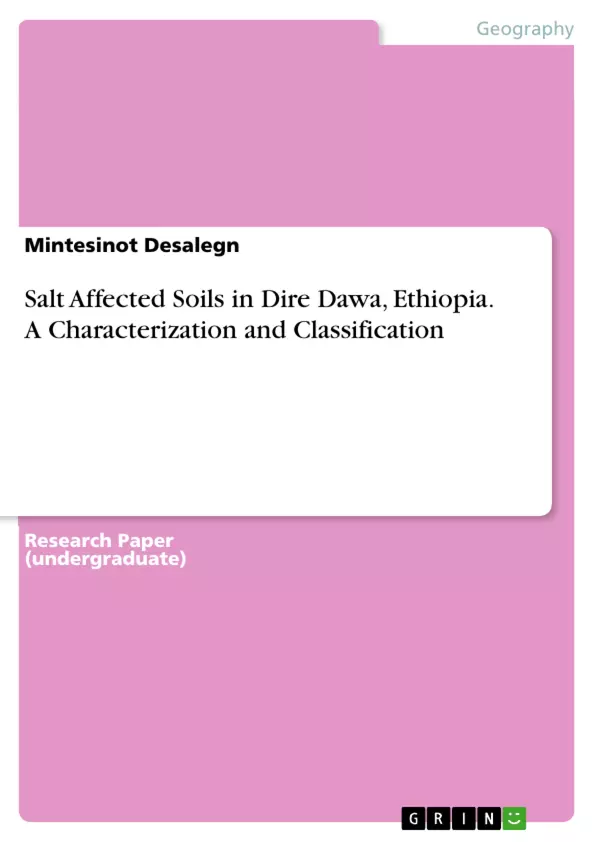The aim of this study was to identify the nature and quantify selectively soil chemical properties of the study area, to characterize and categorize salinity soil based on their salt content of the study area and to give suggestion appropriated reclaim of salt affected agricultural land management practices.
Soil salinity and alkalinity problems are commonly found in the arid and semi-arid regions of the earth due to insufficient annual rainfall to leach accumulated salts from the root zone. In other words, salt affected soils often occur in areas where soluble salts and sodium (Na) accumulate in soils through physical and chemical weathering of rocks or the pedogenic process of the soil development, atmospheric precipitation and fossil salts from marine or lacustrine environments. Moreover, heavy fertilizer application and use of poor-quality irrigation water and inadequate drainage have contributed to the development of salt affected soils and productivity deterioration of many soils in irrigated arid and semi-arid regions.
Ethiopia is the first in Africa and the ninth country in the World having more than 11 million ha of salt affected soils which are mainly found in the Rift Valley, Wabi Shebele River Basin and various lowlands of the country. Following the establishment of large-scale irrigated farms, the problem become worse due to poor drainage system and inappropriate water management practices coupled with unsound reclamation procedures,
To understand how improved soil fertility may assist in reaching these needs, it requires knowledge of salinity and sodicity related soil chemical properties the soils of the land’s agriculture. Such knowledge is believed to help the producers and production managers to understand about and make the necessary modifications in the soil-salt-water balance.
Inhaltsverzeichnis (Table of Contents)
- INTRODUCTION
- LITERATURE REVIEW
- Definition to Describe Salt Affected Soils
- Salt Affected soils in Ethiopia
- Causes of Stalinization and Saline Soil
- Saline soils
- Classification of saline soil
- Saline-Sodic Soils
- Sodic soils
- Causes of salt affected soils
- Primary salinity
- Secondary salinity
- Tests to quantify and qualify soil saltiness
- Impact of Salt Affected Soil on Plant
- Osmotic effect of salt
- Nutrition and ion toxicity of salt
- Structure and permeability problem of salts in the soil
- Adaptations of salt tolerant plants
- Some salt tolerant plants
- Other reclamation methods of salt affected soils
- MATERIALS AND METHODS
- Study area description
- Method Of Sampling Collection and Preparation Sampling Units
- Soil Extraction methods preparation.
- Soil Sample laboratory analysis methods
- Quantify The Soil pHe and Ece From Saturated Extraction.
- Determination of soil Soluble Exchangeable base ( Na +2 , K+, Ca2+ and Mg +2).
- Estimation of Soil Soluble Na + and K+ by using the flame photometer Instrument
- Estimation of soil Ech. Ca2+ and Mg 2+ by using the AAS instrument.
- Estimation of Soil Sample SAR, ESP and ESR for Soil Sample for study site.
- SOIL SAMPLE RESULT AND DISCUSSION
- Characteristics of Chemical Properties of Soil Sample at Study Area
- Soil pH and Electrical Conductivity Result interpretation and Discussion
- Exchangeable Soluble cations result Interpretation and Discussion
- Sodium adsorption ratio (SAR) and Exchangeable Sodium percentage (ESP)
- The study delves into the identification and quantification of soil chemical properties in the Dire Dawa region, focusing on parameters like pH, Electrical Conductivity (EC), Sodium Adsorption Ratio (SAR), and Exchangeable Sodium Percentage (ESP).
- It aims to categorize and classify salt-affected soils based on their salt content, considering various soil parameters like EC, SAR, and ESP.
- The study explores the impact of salt accumulation on plant growth, including osmotic effects and nutrient availability.
- It investigates the effectiveness of different reclamation methods for salt-affected soils, including chemical amendments and biological management practices.
- The study aims to provide recommendations for sustainable land management practices to address the problem of salt-affected soils in Dire Dawa.
Zielsetzung und Themenschwerpunkte (Objectives and Key Themes)
This study aims to characterize and classify salt-affected soils in Dire Dawa, Ethiopia, based on their salt content. It specifically focuses on quantifying soil chemical properties, identifying the nature of salinity, and proposing appropriate reclamation and management practices for salt-affected agricultural lands.
Zusammenfassung der Kapitel (Chapter Summaries)
The first chapter introduces the research problem of soil salinity and alkalinity in arid and semi-arid regions, particularly in Ethiopia. It highlights the significance of salt-affected soils in terms of agricultural productivity and environmental degradation. This chapter also outlines the study's objectives and research methods.
Chapter 2 delves into a comprehensive literature review on salt-affected soils, covering their definition, classification, causes, and impacts on plant growth. It explores the role of both natural and human-induced factors in the development of soil salinity and discusses various methods for quantifying soil saltiness.
Chapter 3 details the materials and methods used in the study, including the description of the study area, the soil sampling procedures, and the laboratory analysis techniques employed to determine soil chemical properties.
Schlüsselwörter (Keywords)
The study focuses on salt-affected soils, their characterization and classification based on soil chemical analysis. Key parameters used in the study include electrical conductivity (ECe), pH, exchangeable sodium percentage (ESP), and sodium adsorption ratio (SAR), all of which are essential for understanding soil salinity and sodicity. The research further delves into salt-tolerant plants and reclamation methods for sustainable land management.
- Arbeit zitieren
- Soil Science Mintesinot Desalegn (Autor:in), 2019, Salt Affected Soils in Dire Dawa, Ethiopia. A Characterization and Classification, München, GRIN Verlag, https://www.hausarbeiten.de/document/938969


